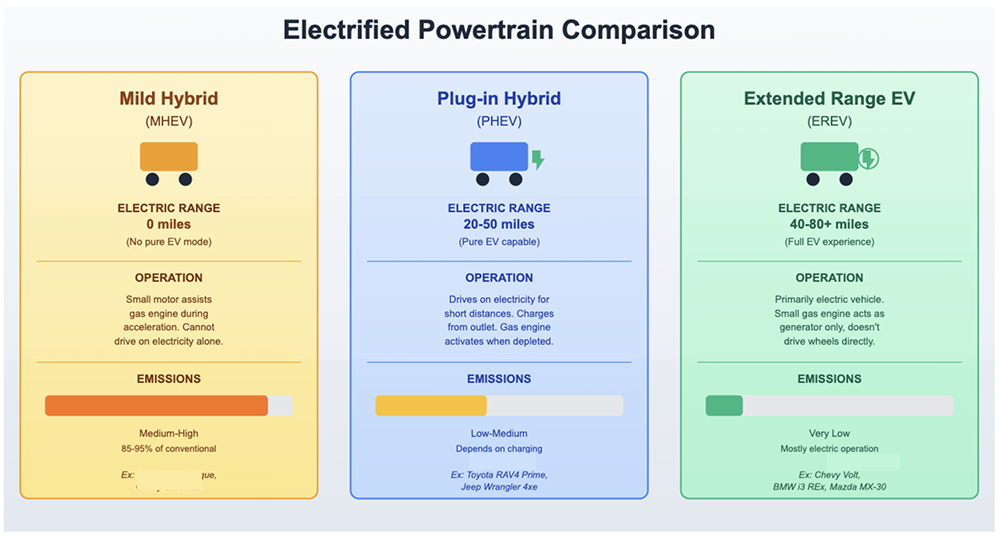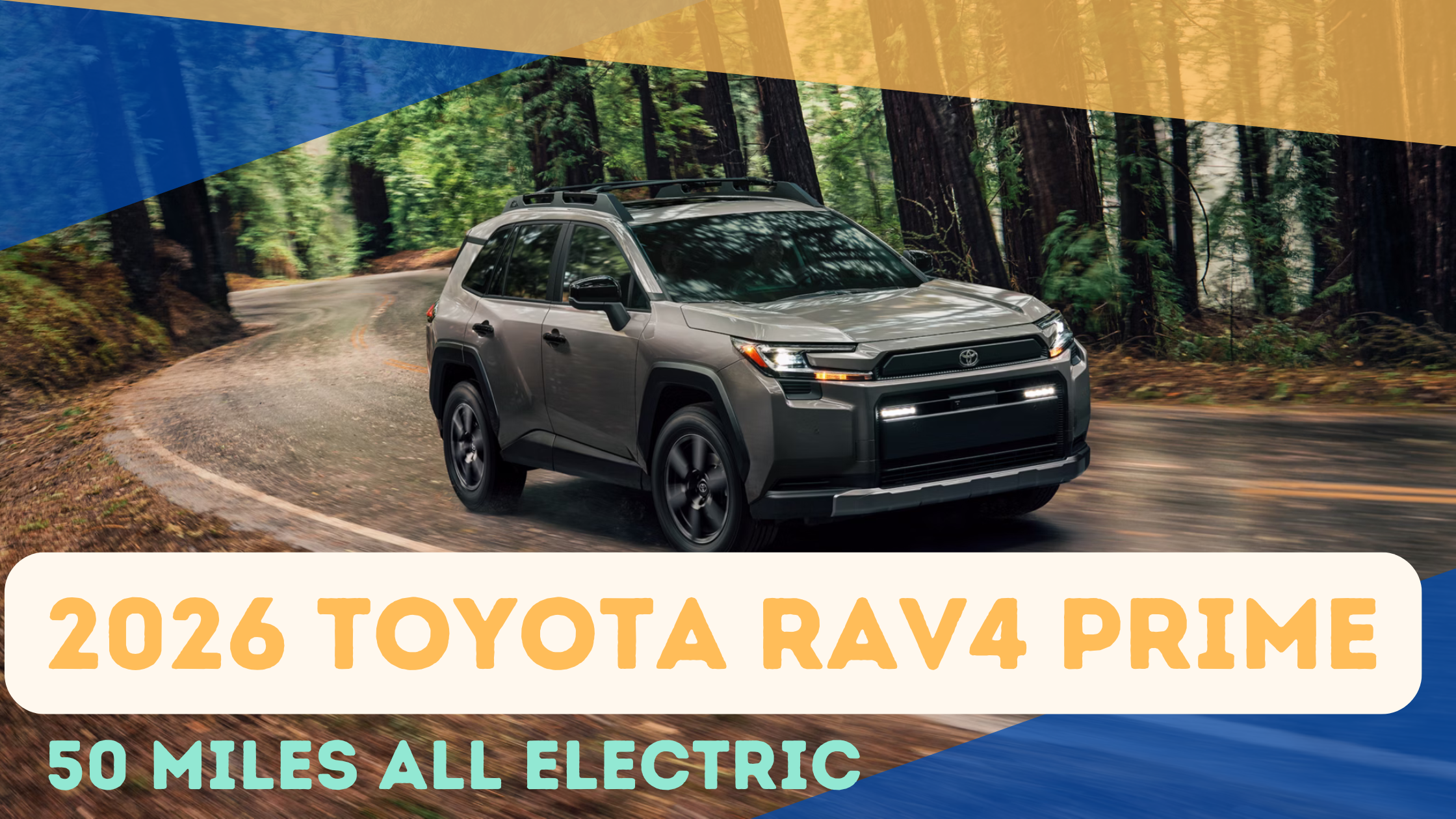Let’s break down the different types of hybrid cars.
- Mild hybrids (HEV) have both electric drive systems and batteries but the batteries cannot drive the car, but they do increase fuel efficiency. These hybrids cannot be plugged in. Instead, the small battery is recharged through regenerative braking and the internal combustion motor. While they are “electrified,” hybrids are not considered “clean vehicles” because their batteries are too small to drive the car at proper road speeds.
Think: original Toyota Prius, Hyundai Sonata, Honda CR-V – there are a lot of mild hybrid versions of popular cars.
- Plug-in Hybrids (PHEV) are the next step in electrification. They have small batteries that can drive the car, meaning that they can usually get 20-50 miles emission-free. Depending on the car’s configuration, the gas engine will kick in at high speeds, uphill, or in certain modes. PHEVs can be plugged in and refilled at a gas station. Note: they are only clean vehicles if you actually plug them in!
Such as: Toyota Prius Prime, Jeep Wrangler 4xe, Chrysler Pacifica PHEV
- EREV (series hybrid, range extended EV) are a type of plug-in hybrid that uses battery power as the primary propulsion, with a gas generator that can recharge the battery when it gets low. These are the “cleanest” plug-ins, since they will not use the gas engine until necessary, relying only on battery power for as long as they can. Many automakers have EREV models planned for the coming years since they all but eliminate range anxiety for new EV drivers.
For instance: BMW i3 REx, Chevrolet Volt, Scout Traveler Harvester. Many EREV models are planned for the coming years.

Shout out to the BMW i3 REx
The BMW i3 REx is a cult classic electric car that is often lumped in with other PHEVs, due to its gas powered range extender. However, its electric range in later year models was 126 miles (72 for early years), and for this reason, we have disqualified it from the rankings.
Moreover, the i3 was originally designed as an all-electric, with the REx being an option. As a true EREV, the gasoline engine in the REx does not drive the wheels directly; it acts only as a generator to recharge the battery when it is depleted. In contrast, in typical PHEVs, the internal combustion engine can contribute mechanical power to the drivetrain.
Longest Range PHEVs in 2026
Longest Range PHEVs from 2018-2025
2026 Winner: Longest Range Luxury PHEV >> Mercedes-Benz GLE 450e
EPA Electric Range: 49 miles
Estimated Total Range: 500

2026 Winner: Longest Range Affordable PHEV >> Toyota RAV4 Prime
EPA Electric Range: 50 miles
Estimated Total Range: 550

2018 - 2025 Longest Range PHEVs
Note: maximum EV range across model years and trims was used

Mercedes GLC (including GLC 350e PHEV variant)
54 all electric, 380 total
The Mercedes GLC delivers a refined and comfortable ride, with a plush cabin, quiet insulation, and smooth acceleration with added electric assist. It leans more toward luxury comfort than sport, which some drivers find less agile than rivals in twisty driving. On the downside, some drivers also complain about uneven regenerative braking behavior, leading to a “mushy” pedal feel that’s harder to modulate. Additionally, the substantial premium over the non‑PHEV GLC (up to $10,000 more) can be hard to justify unless you consistently exploit its electric range.

Chevy Volt (extended-range EV)
53 all electric, 420 total
The Chevy Volt, like the i3 REx, functions as an extended range EV, rather than a true PHEV, but due to its electric range, we’ve included it here. The Volt is all about versatility: it can run on pure electric power for daily driving, yet the gas engine alleviates range anxiety on longer trips. Owners often highlight strong efficiency, smooth performance in EV mode, and relatively low operating costs over time. Common complaints include aging electrical components, the cost and availability of battery or drivetrain repairs in older units, and some decline in electric range over time. Also, since production has ceased, replacement parts and dealer support can be variable depending on region.

Honda Clarity Plug-In Hybrid
48 all electric, 340 total
The Clarity PHEV offers one of the more generous all-electric ranges in its class (officially ~47 miles in many cases) and provides a smooth, quiet ride in electric mode. It generally scores well for interior comfort, roomy cabin, and daily usability. On the flip side, its acceleration isn't always strong in EV mode, though it improves in hybrid mode, and the transition between electric and gas driving can feel somewhat disjointed . Also, because it is no longer produced, future maintenance and support can present challenges.

Toyota Prius Plug-In Hybrid
45 all electric, 640 total
The Prius Plug-In is Toyota’s first plug-in model, after years of success with their conventional, mild hybrids. It is well known for its fuel efficiency and refined hybrid systems. It offers good plug-in range, solid mpg when running as a hybrid, and Toyota’s reputation for reliability. Many owners find its transitions smooth and its controls intuitive. Critics often point to the compromise in interior space since the battery takes up cargo room, and comparatively slower EV charging speeds vs peers. Once the battery is depleted, the hybrid mode is efficient but can feel underpowered.

Toyota RAV4 Plug-In Hybrid
42 all electric, 600 total
The RAV4 Plug-In balances utility and electric range in a wildly popular package. With 42 miles of EV mode, strong horsepower, and standard all-wheel drive, it’s among the most performance-capable PHEVs in the SUV class. It also enjoys solid build quality and Toyota’s service network. But it’s not flawless: reviewers often note soft steering feel, less engaging handling, and brake pedal feel that sometimes lags behind premium benchmarks. The infotainment system has drawn criticism for occasional glitches or lack of responsiveness in some units. As with many SUVs, the extra battery weight can affect agility.

Volvo V60 Polestar Engineered
40 all electric, 530 total
The Volvo V60 Polestar Engineered blends the practicality of a wagon with a performance-focused hybrid powertrain. It offers strong electric assist, brisk acceleration, and refined driving dynamics that feel more premium than many hybrids. The interior is upscale, and the character is distinct from typical crossovers or sedans. That said, it's not without drawbacks: the ride can be firm, especially in performance settings, and the added complexity (hybrid + performance tuning) can lead to higher maintenance or repair costs. Electric-only range is modest relative to full EVs, making it more of a performance hybrid than a full-range replacement.




